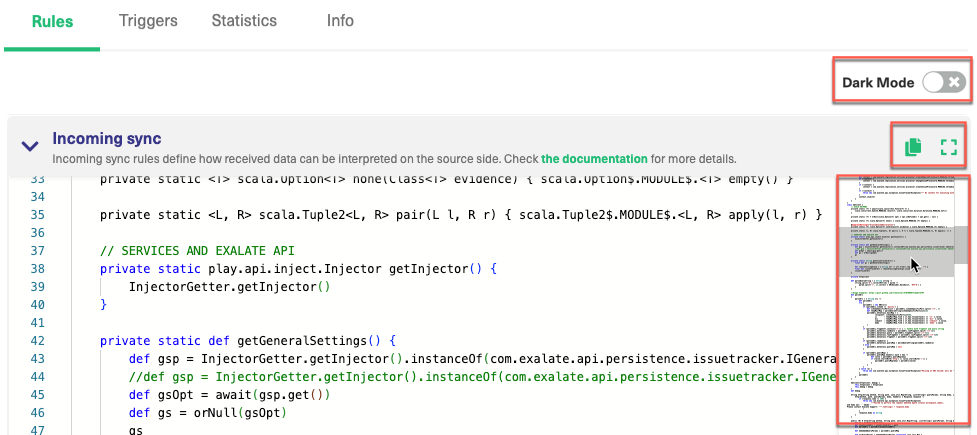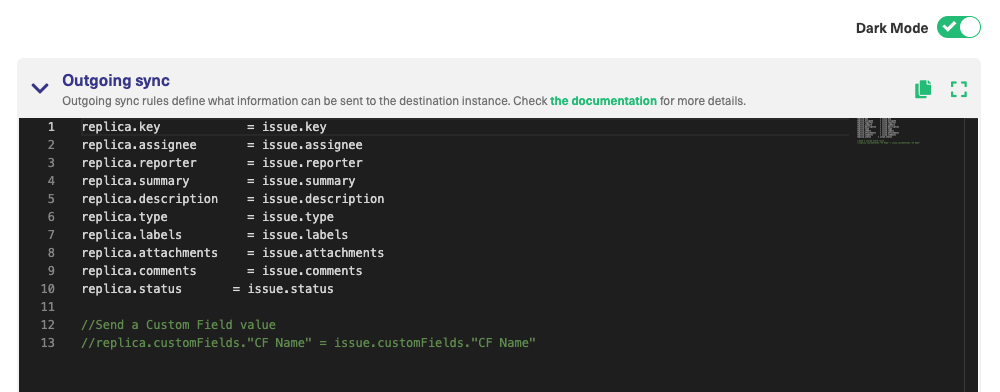Exalate uses synchronization rules (Sync Rules) to handle outgoing and incoming messages. You can find Sync Rules as a separate tab when you select the connection to edit.
Note: For script connections, Exalate is using the Monaco editor with Groovy support.
Note: Starting with Exalate v. 8.5.1 we are running Groovy v. 4.
Editor Features
- Light Mode: Use to toggle to switch between Dark and Light mode
- Copy: Copy Incoming/Outgoing code blocks to the clipboard.
- Expand: Expands the code editor window for a better view if needed.
- Mini Code Map: Allows you to quickly navigate through the code, useful when dealing with longer code blocks.

Dark Mode on:

Expanded mode on (Dark mode):

In the Sync processors, the Monaco editor library allows for auto-complete, syntax highlight and syntax errors highlight when writing sync rules.

How to create a Sync Rule
Sync rules are groovy-based scripts that can be used to implement filtering, mapping, and transformation. These are essential operations in any synchronization.
Groovy is a dynamic language for the Java platform. Check out the following links to get more details about Groovy and how to develop in this language:
- http://www.groovy-lang.org/
- http://www.groovy-lang.org/learn.html
- http://www.groovy-lang.org/documentation.html
Groovy learning courses that we can recommend:
- https://www.pluralsight.com/courses/groovy-getting-started
- https://www.pluralsight.com/courses/groovy-fundamentals
Sync rule types
There are 2 different types of Sync Rules, each with its own purpose.
- Outgoing sync
- Incoming sync
Note: For more information please see the synchronization process explanation.
Outgoing sync
This rule defines what information is sent to the destination side.
Exalate runs the outgoing sync processor when you start the synchronization or update the local issue which is under sync.
You can assign issue fields to a replica on the outgoing sync. For more information on this, see issue fields available for synchronization.
| Variable | Explanation | |
| Input | issue | local issue data you need to synchronize |
|---|---|---|
| Output | replica | copy of the issue data which is sent to the destination instance |
Simple examples of Outgoing sync rules
1 replica.summary = issue.summary// send summary2 replica.description = issue.description// send description3 replica.comments = issue.comments// send comments4 replica.attachments = issue.attachments// send attachments
Condition example in the Outgoing Sync rules
Don't send anything when priority is trivial
1 // If the issue priority is "Trivial" don't send any data. In other cases send the summary, description, comments and attachments23 if(issue.priority.name =="Trivial") {4return5 }6 replica.summary = issue.summary7 replica.description = issue.description8 replica.comments = issue.comments9 replica.attachments = issue.attachments
Incoming sync
When you receive data from the other side you need to apply this data on your instance. You can define how to handle the received information on your instance with the help of the incoming sync rules.
Exalate runs the incoming sync every time there's new data received from the remote side.
When you receive the synchronization data from the remote side for the first time, Exalate creates the issue locally in your instance.
Starting from this moment the issue is considered under synchronization(under sync). From that moment every issue update triggers the update of the synced issue on the other side.
| Variable | Explanation | |
| Input | replica | Information received from the source instance |
| Output | issue | Issue object which is used to create/update the local issue |
| previous | Previous information received from the source instance |
Important: When you leave the incoming sync empty, nothing is synchronized. Please see the Unidirectional synchronization for more details.
Simple Incoming sync example
1 if(firstSync){2// If it's the first sync for an issue and local copy of the issue does not exist yet3// Set project key from source issue, if not found set a default4issue.projectKey = nodeHelper.getProject(replica.project?.key)?.key ?:"TEST"5// Set type name from source issue, if not found set a default6issue.typeName = nodeHelper.getIssueType(replica.type?.name, issue.projectKey)?.name 7. 7 ?:"Task"}8issue.summary = replica.summary9issue.description = replica.description10issue.comments = commentHelper.mergeComments(issue, replica)11issue.attachments = attachmentHelper.mergeAttachments(issue, replica)
Note: Incoming requests are distinguished based on the information stored in a replica. So if you want to have different sync rules for the first synchronization and then others for synced issue updates, you should use conditional statements.
1 if (firstSync) {2 return // don't create any issues, only sync changes to the issue which are already under sy3 nc}4 issue.summary = replica.summary5 issue.description = replica.description6 issue.labels = replica.labels7 issue.comments = commentHelper.mergeComments(issue, replica)8 issue.comments = attachmentHelper.mergeAttachments(issue, replica)
More advanced configuration
You can set your own values for the local issue based on the received data from the other side. For example, if the synced issue status changes to Done on the remote side → set the local issue status to Resolved.
To configure advanced conditions for your synchronization use script helper methods.
Check the example below:
1 // Create a request in the support project "SD", but if it's a critical issue in the customer's WEB project, assign it to Bob Price23 issue.project = nodeHelper.getProject("SD")45 if (replica.priority.name = "Critical" && replica.project.key = "WEB") {6 issue.assignee = nodeHelper.getUser("bprice") // assign to Bob7 issue.priority = nodeHelper.getPriority("Blocker")8 } else {9 issue.priority = nodeHelper.getPriority("Major")10 }11 12 issue.summary = replica.summary13issue.projectKey = "SD"issue.typeName = "Request"
Default configuration
By default, Exalate configures some basic scripts in the Sync Rules for your convenience. Below is the default configuration of the Outgoing and Incoming sync.
It helps to synchronize basic issue data: summary, description, comments, resolution, status, attachments and project.
Default Outgoing sync
1 replica.key = issue.key2 replica.type = issue.type3 replica.assignee = issue.assignee4 replica.reporter = issue.reporter5 replica.summary = issue.summary6 replica.description = issue.description7 replica.labels = issue.labels8 replica.comments = issue.comments9 replica.resolution = issue.resolution10 replica.status = issue.status11 replica.parentId = issue.parentId12 replica.priority = issue.priority13 replica.attachments = issue.attachments14 replica.project = issue.project
Default Incoming sync
1 if(firstSync){2 // If it's the first sync for an issue (local issue does not exist yet)3 // Set project key from source issue, if not found set a default4 issue.projectKey = nodeHelper.getProject(replica.project?.key)?.key ?:"TEST"5 // Set type name from source issue, if not found set a default6 issue.typeName = nodeHelper.getIssueType(replica.type?.name, issue.projectKey)?.name ?:"T ask"}7 issue.summary = replica.summary8 issue.description = replica.description9 issue.comments = commentHelper.mergeComments(issue, replica)10 issue.attachments = attachmentHelper.mergeAttachments(issue, replica)
